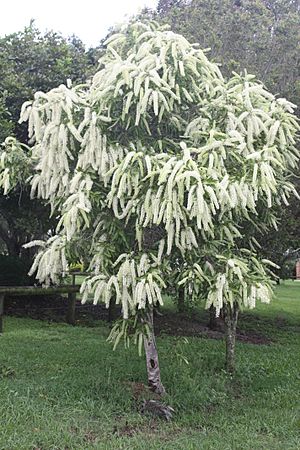Ivory curl tree facts for kids
Quick facts for kids Ivory curl tree |
|
|---|---|
 |
|
| Scientific classification | |
| Genus: |
Buckinghamia
|
| Species: |
celsissima
|
The Ivory Curl (scientific name: Buckinghamia celsissima) is a beautiful tree from the plant family called Proteaceae. You can only find these trees growing naturally in the wet rainforests of northeastern Queensland, Australia.
Contents
Discovering the Ivory Curl
This special tree was first described in 1868 by a scientist named Ferdinand von Mueller. He named it to honor Richard Grenville, who was the 3rd Duke of Buckingham. The tree's scientific name, celsissima, comes from a Latin word meaning "very tall." People also call it the ivory curl flower or spotted silky oak.
What Does the Ivory Curl Look Like?
Size and Leaves
In its natural rainforest home, the Ivory Curl tree can grow super tall, up to 30 meters (about 98 feet)! But when it's planted in gardens along Australia's east coast, it's usually much smaller, reaching around 10 meters (about 33 feet) tall.
Its leaves are shiny and dark green on top, and a bit whitish underneath. Young trees have leaves with one or more wavy edges. As the tree gets older, the leaves become simpler and smoother. They are usually 8 to 16 centimeters (about 3 to 6 inches) long and 3 to 7 centimeters (about 1 to 3 inches) wide.
Flowers and Fruits
The Ivory Curl tree gets its name from its amazing white flowers. These flowers grow in long, hanging bunches called racemes, which can be up to 20 centimeters (about 8 inches) long. They are very showy and appear during summer and autumn.
After the flowers bloom, they turn into woody seed pods, called follicles. These pods are about 1.5 to 3 centimeters (about 0.6 to 1.2 inches) long.
Where It Grows Naturally
In the wild, you'll often find Ivory Curl trees in drier parts of the rainforest. They usually grow at higher altitudes, from 200 to 1000 meters (about 650 to 3,300 feet) above sea level. They often share their habitat with another tall tree called the kauri pine (Agathis robusta).
Growing the Ivory Curl Tree
The Ivory Curl tree is a popular choice for gardens in many parts of Australia. It grows very well in cities like Brisbane, Sydney, and Melbourne. However, it doesn't flower as much in Cairns. It also struggles to grow in colder places like Canberra because it doesn't like frost.
You can grow new Ivory Curl trees from seeds or from cuttings. Its beautiful flowers are a magnet for birds and insects, which helps them spread their seeds and pollen.

